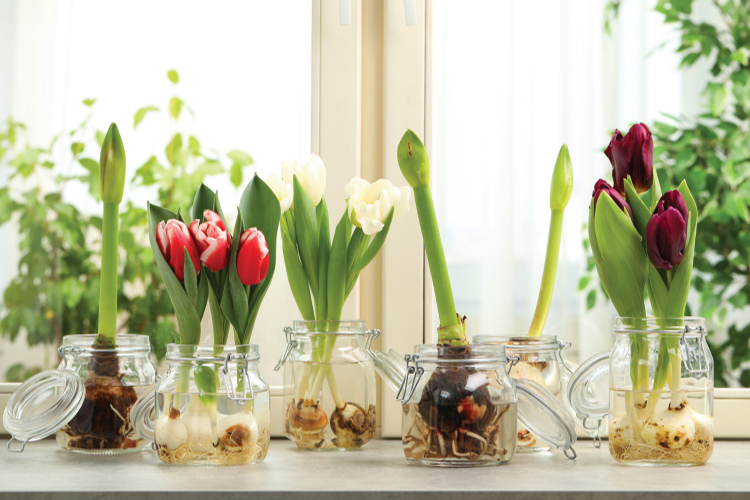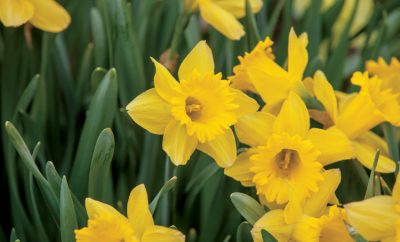Battle of the Bulbs: Fall Planning & Planting

Photo credit: iStock/Liudmila Chernetska
It’s never productive to try and rush time, except maybe in fall, when our minds move to spring, and we pick out bulbs for the garden. Spring-blooming bulbs, such as tulips, daffodils, hyacinths and many others, are planted this time of year, and the goal is to enjoy their beauty several months from now.
The cool thing about bulbs is they are programmed to grow and release the spring flowers tucked away inside. September through mid- to late-October is the best time to plant spring bulbs. They should be in the ground four to six weeks before the soil freezes.
How to Plant Bulbs
- Plant bulbs in a hole two to three times as deep as they are tall. For example, if a bulb is 2 inches tall, plant it 4 to 6 inches deep. Err on the deeper side.
- Because bulbs are programmed to grow, fertilizer in the planting hole is not needed.
- Plant bulbs, such as allium, tulips, daffodils and Dutch hyacinths, pointy end up. Some types of bulbs are corms, such as crocus. Corms are flat on top and don’t have points but usually have fine roots on the bottom.
- After planting, water well. Cover with chopped leaves, shredded bark or other mulch.
Location, Location
Sunny areas with well-drained soil are the ideal locations for planting. Think about what existing perennials you have and which bulbed plants will complement them. Planting bulbs amid other perennials helps camouflage the bulbs’ leaves as they age and ripen.
The leaves need to stay attached to the underground bulbs for about six weeks after they bloom. The leaves feed the bulbs the nutrients needed to bulk up for next year’s flowers.
Bulbs can be planted with coral bell (Heuchera), hosta, hellebores, lady’s mantle, asters, daisies and many other companion perennials.
Effortless Effect
Smaller spring bulbs, such as scilla, grape hyacinth, glory-of-the-snow and crocus, are excellent for naturalizing – planting in an informal or unplanned pattern – on the lawn or under trees and shrubs. They only need to be planted an inch or two below the soil surface. Avoid planting daffodils and tulips to naturalize on the lawn because the grass likely will need to be mowed before the foliage of the bulbs should be cut off.
Varmint Vandals
The greatest damage to newly planted spring bulbs comes from squirrels and voles. The voles burrow and chew on the underground portion of bulbs, and squirrels usually dig up the bulbs. Squirrels seem to recognize newly planted bulbs, likely from the disturbed soil.
To protect bulbs from squirrels, place chicken wire, hardware cloth, window screen or something similar on top of the newly planted area. Use landscape staples to keep the protection in place. In spring, as soon as you see the bulbs break ground, remove the protection.
For voles, use hardware cloth to make baskets the size to accommodate the bulbs. Enclose the bulbs in the basket. For this method, it’s better to make the basket large enough to handle three to five bulbs.
Look at some animal repellents that will work on the critters you are trying to control. Plantskydd and Bonide are two brands. Always read and follow the label directions. These products may also be used once the bulbs, especially tulips, are up and look inviting to deer.
Spring Forward
Cut a few spring bulbs for indoor use. While doing that, look at the garden to see where more bulbs will need to be planted in the future and what color they should be. Think about possibly planting perennials to help camouflage the bulbs’ leaves as they ripen.
About the Author: Jo Ellen Meyers Sharp, hoosiergardener.com, is available for in-person or remote programs about gardening, native plants, sustainable living and what to avoid planting. Please see Great Garden Speakers for reviews.
See more: 3 Native Shrubs to Bring a Burst of Color to Your Fall Landscape













 My Indiana Home is produced for Indiana Farm Bureau members. Our mission is to connect you with the food you eat, the Indiana farmers who grow it and a rural lifestyle that is uniquely Hoosier.
My Indiana Home is produced for Indiana Farm Bureau members. Our mission is to connect you with the food you eat, the Indiana farmers who grow it and a rural lifestyle that is uniquely Hoosier.
Leave a Comment